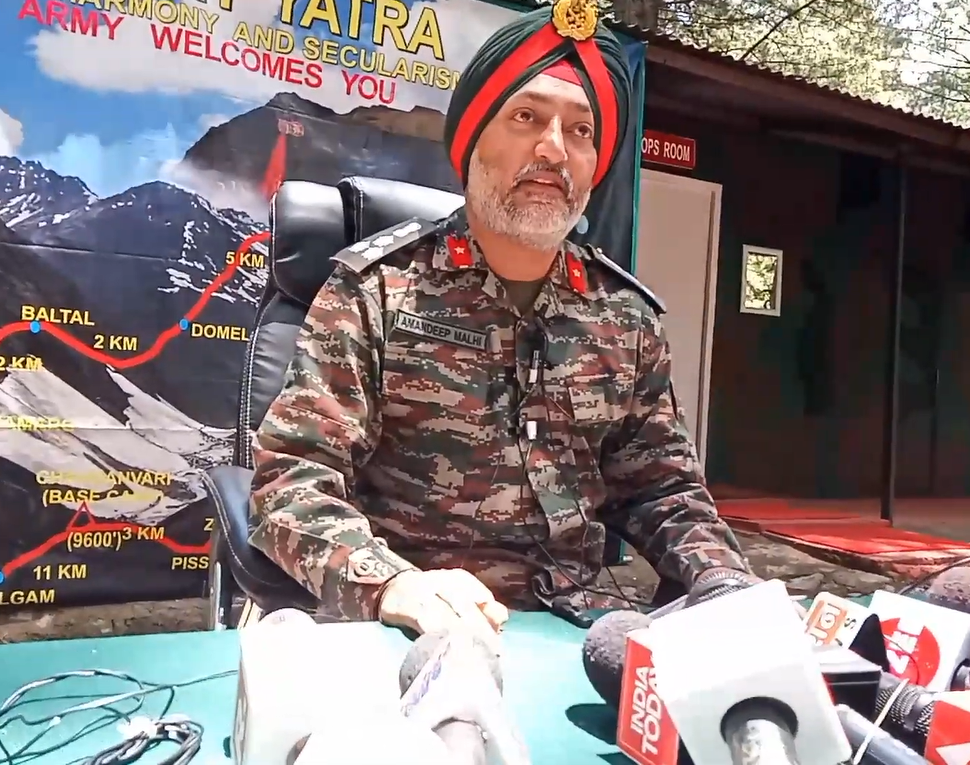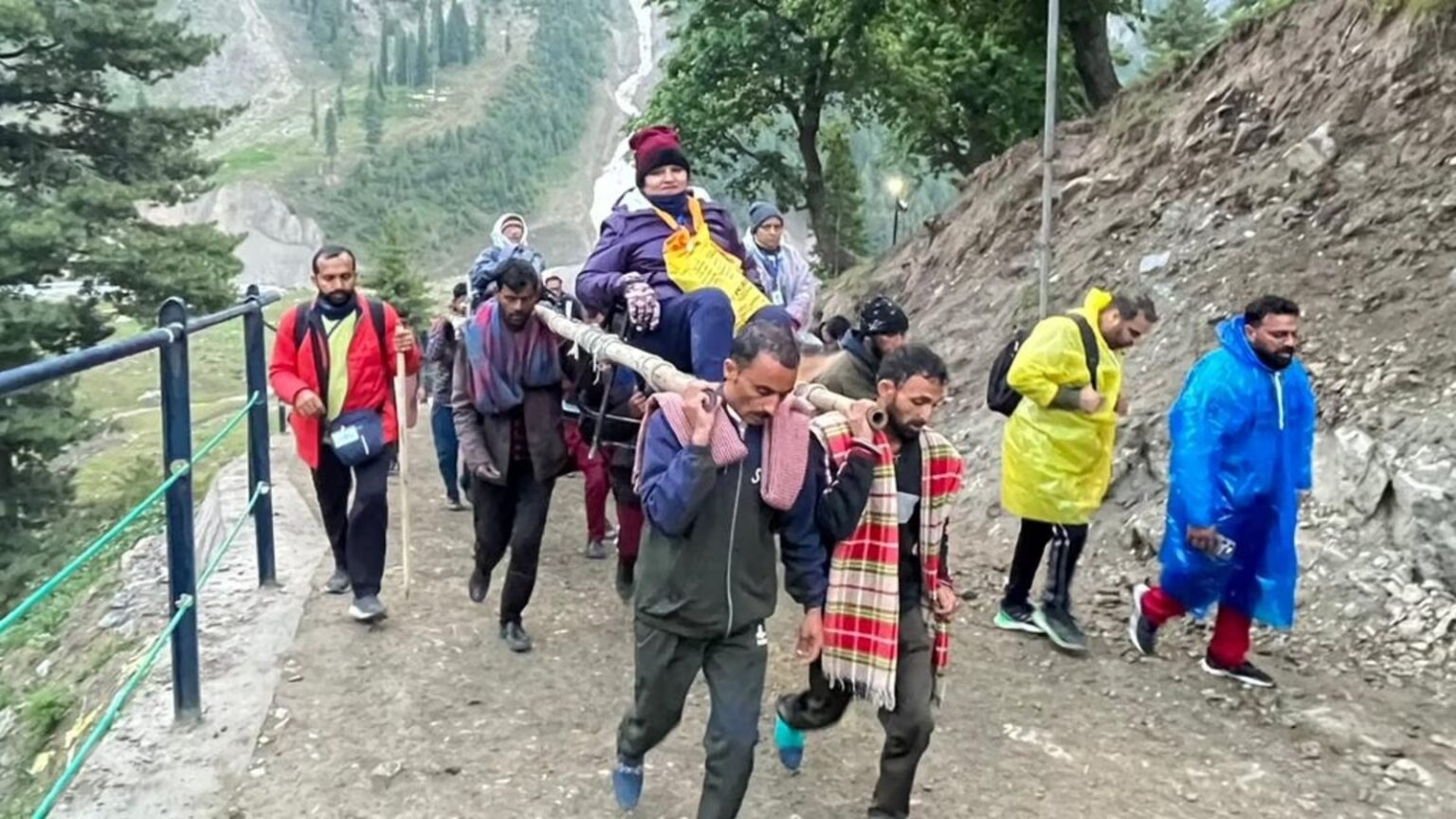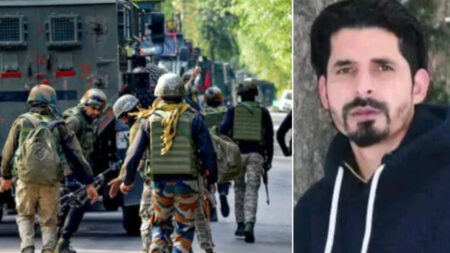The 62-day holy Amarnath yatra began along the twin roads of Baltal and Nunwan-Pahalgam on the First of July.
At the cave temple at 3880 meters in the South Kashmiri Himalayas, 7959 pilgrims performed darshan of the naturally created Ice Lingam on day 1.

Lt. Governor Manoj Sinha, who also serves as the chairman of the Shri Amarnath Shrine Board (SASB), presided over a meeting to examine the management of the Control Room that was established at Raj Bhawan for the yatra.
With the officers of the control center, the Lt. Governor went through queue management, the deployment of security personnel, the use of women constables, the operation of langers and security forces at the lower holy cave, the installation of fences, and heli services.
He also expressed his appreciation for the team’s excellent job.
To facilitate a hassle-free pilgrimage, the Shri Amarnath Ji Shrine Board’s (SASB) Control Room is staffed 24 hours a day and coordinates with numerous stakeholders on the ground.
The Lt. Governor announced that significant efforts have been undertaken to enhance pilgrim facilities, ensuring the utmost comfort and making the spiritual journey an enjoyable experience.
Senior leaders including Rahul Singh, Additional CEO of the SASB, Dr. Mandeep Kumar Bhandari, CEO of the Amarnath Ji Shrine Board, and others attended the meeting.
The second group of pilgrims
According to officials, a second group of more than 4,400 pilgrims left the Bhagwati Nagar Yatri Niwas in a convoy for the holy cave, and 7959 people did darshan of a naturally formed Ice Shiv Lingam at the cave shrine up to 1900 hours today.
They included 6220 men, 1449 women, 198 infants, 91 Sadhus, and one Sadhvi, according to officials, who also noted that the yatra began early this morning from the twin base camps of Nunwan and Baltal towards the holy cave.
The first wave of pilgrims was flagged off from both tracks early this morning, Nodal Officer SASB Piyush Singla told media at Nunwan.
According to him, all boarding and lodging facilities are set up along the routes, and the pilgrims are in good spirits.
The third group of pilgrims departs for Kashmir
On Sunday, a new group of 4,903 pilgrims departed from the base camp to begin the yearly journey to the 3,880-meter-high cave shrine of Amarnath in the south Kashmir Himalayas, according to officials.
With this, a total of 12,807 pilgrims have made the journey since Lt. Governor Manoj Sinha set off the first group on June 30.
On the opening day of the 62-day yatra, which began on Saturday from both of the twin tracks – the traditional 48-km Nunwan-Pahalgam route in Anantnag district and the shorter but steeper 14-km-long Baltal route in Ganderbal district – around 8,000 pilgrims offered prayers at the shrine.
According to the authorities, 2,557 worshippers, including 379 women and 226 sadhus, departed in 104 cars for Pahalgam, while 2,346 pilgrims departed in a convoy of 131 vehicles for the Baltal base camp early this morning.
Online registration for the trip has so far drawn more than 3.5 lakh individuals.
Safety Precautions for the Amarnath Yatra
According to Piyush Singla, Nodal Officer SASB, Mountain Rescue teams have been stationed on both trails in case of emergency.
At Baltal and Pahalgam, the locals and representatives of the Development Authorities of Pahalgam and Sonamarg gave the pilgrims a warm welcome.

The city of Jammu has established thirty-three lodging facilities, and pilgrims are being given Radio Frequency Identification (RFID) tags.
The registration of pilgrims planning to participate in the yatra will be handled by five counters.
To ensure a safe and secure Amarnath Yatra, a strong and flexible security grid has been implemented, including the deployment of snipers, anti-drone systems, bomb disposal, and dog squads.
In order to make sure that the pilgrims’ yatra is safe and secure, the Indian Army has always been involved.
The army has once again collaborated with all other stakeholders to establish a strong and flexible security grid for the Shri Amarnath Ji Yatra.
According to Brigadier Atul Rajput, commander of the army’s 3 Sector Rashtriya Rifles, who spoke to reporters at Baltal.
He said that the army had put in place multi-tiered security measures, including control of the mountains, sanitization of the yatra path, and round-the-clock surveillance utilizing the most advanced night vision technology.
Amandeep Malhi, Commander of Sector 1 RR, stated during a news conference at Pahalgam Base Camp that more amenities have been made available this year to guarantee a smooth and tranquil Amarnath pilgrimage.
We have been using quadcopters and night vision technology to continuously monitor the shrine.

On higher levels, in addition to the army, Central forces and police have been stationed.
Every soldier has received a briefing to ensure that residents are bothered as little as possible throughout the Yatra season, he said.
According to him, mountain and avalanche rescue teams have been sent out to prepare for any situation.
The National Disaster Management Authority (NDMA), the NDRF, the SRDRF, and the army all participated in joint drills this year, he added.
He stated that this year, “quick and effective response teams will ensure fast evacuation in case of any natural calamity.”













